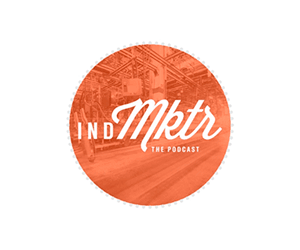Do you ever feel lost when industrial marketers start talking in marketing jargon? Do statements like “Our inbound marketing strategy really made a difference in bringing in some warm leads and advocates this year” make you feel like you’ve stepped off a plane into a foreign country?
Fortunately, it’s not as complicated as it sounds. Once you start organizing marketing buzzwords into some simple “buckets” (i.e., groups), it becomes a lot easier to understand any marketing jargon that may come up.
Outbound Marketing Jargon
Let’s start with Outbound Marketing.
Outbound Marketing refers to selling and marketing where a company instigates the conversation and sends its messages out to audiences that match their ideal customer profile. It is arguably the most traditional method of marketing. Some examples of marketing jargon that you might hear when discussing outbound marketing are Social Selling, Cold Calling, Warm Calling, and Field Sales.
Social Selling is most easily defined as salespeople using social media to interact directly with potential new customers. Salespeople continue to provide answers to potential customer’s questions and other valuable content until the prospect is ready to purchase a product or service.
Cold Calling is a term that most people are familiar with. Similar to telemarketing, it is when a person makes an unsolicited phone call to pitch the need for their product or service. The contact information a cold caller uses is often gathered from a purchased list. This technique can also include the creation of unsolicited emails as well.
Warm Calling is slightly different than Cold Calling. When engaging in Warm Calling, you may not have a relationship with the person you are reaching out to, however, they will have shown some sort of interest in you or your company.
Field Sales is the name of the salesforce that personifies the above techniques. Often these individuals work remotely and pound the pavement in order to turn both cold and warm leads into customers.
What does each of these things have in common? They all require reaching out to those who may not be looking for you. Because Outbound Marketing usually requires convincing a potential customer of their need for your product or service, the response rate is often lower than other forms of marketing.
Inbound Marketing Jargon
The second bucket of marketing jargon to sift through is Inbound Marketing.
Inbound Marketing refers to marketing where a company attracts customers by delivering engaging, useful, and actionable content that buyers need in order to solve problems and ultimately do business with the company engaged in inbound marketing. Similar to Outbound Marketing, the name speaks for itself, as the goal is for customers to come in to your world based on information that you make available, rather than you pushing information out to them. A few important phrases to know are Earned Media, Owned Media, Paid Media, and Social Media.
Earned Media is when unpaid avenues start to drive attention to your brand or a product or service you offer. This could be a positive review or the editor of an industrial trade magazine asking you to contribute an article. New prospects tend to view earned media advocates as trusted sources, making this channel especially valuable.
Owned Media is the term used to describe media offerings your company makes available to potential customers. This is often content-based. Examples include your website, a blog or webinar, and case studies.
Paid Media is likely familiar to most people. Traditional advertising falls into this bucket. But really any sort of outreach that a company pays for is considered Paid Media.
Social Media covers any platform where people engage with one another online. Facebook, Twitter, YouTube, and LinkedIn (as well as others) are all considered Social Media. As the platforms grow, so does the opportunity to engage with potential customers. It is also important to note that each platform serves a different purpose, so creating content that is unique to each is key to garnering attention and increasing engagement and online traffic.
One more note about Inbound Marketing. Not only is it on point to continue to be the future of marketing, it is often less expensive than Outbound Marketing. Because it is designed to make potential customers come to you, the response and conversion rates are usually higher.
Using the 3Rs to Make Sense of Yet More Marketing Jargon
Finally, let’s take a look at a concept that I like to call the “3Rs” (Relationships, Reputation, and Referrals). Even with the most successful Outbound and Inbound Marketing, sustainable success is unlikely without keeping an eye on these three key aspects of a business. Most people have a good idea of what these are, however, there are a few terms that should be teased out, such as Customer Loyalty, Customer Satisfaction, Reputation Management, Advocates, and Successful Referrals.
Customer Loyalty is when a person or company purchases a brand on an ongoing basis. However, with the growing value of Inbound Marketing, Customer Loyalty can now be measured through advocacy on social media or general evangelism about your product or service. With industrial marketing in particular, this sense of loyalty is often developed through a personal relationship between individuals.
Customer Satisfaction is also based in a relationship. While it is important for your customer to be satisfied with your company’s offering, satisfaction is also tied to what happens when there is a problem. Developing a solid relationship with your customer can sustain loyalty, even when difficult times arise.
Reputation Management is two-pronged: Online Reputation Management (ORM) and Public Relations/offline reputation management. Understanding these concepts is really quite simple. ORM involves proactively staying aware of customer reviews and other comments on social media. Responding and engaging through social media in a timely manner builds trust and a sense of relationship. Offline Reputation Management/Public Relations is a little more familiar to most people. It involves managing the public perception of your company proactively, but also reactively if needed, through traditional media means.
Referrals are the culmination of successful 3Rs work. By managing your reputation and cultivating existing customer relationships, you will have created a team of Advocates. Advocates are customers who refer prospects to your company by recommending your products or services.
When Tempted by Marketing Jargon, Keep It Simple
Industrial marketers will do well to keep it simple — not only for themselves but for those they need to work with. The outbound, inbound, and 3Rs categorizations can be great tools for helping you communicate all the great things marketing can do and keep everyone on the same page. It can also help any collaborators in fields other than marketing understand what you’re saying.
So don’t feel shy about sharing this “decoder ring” with stakeholders you need to communicate with in order to do your job as an industrial marketer effectively. And if you have questions about how to communicate effectively with your colleagues, send me a message on LinkedIn. I’d love to help you with translation!




